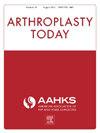评估混合现实技术对全髋关节置换术手术室时间的影响:一项比较研究
IF 2.1
Q3 ORTHOPEDICS
引用次数: 0
摘要
背景:为了帮助指导全髋关节置换术(THA)中髋臼部件的定位,计算机辅助设备,如机器人、导航和混合现实(MR)已被纳入手术室,结果不一。本研究旨在确定使用磁共振技术对手术时间的影响。方法:本研究回顾性分析了从2021年1月1日至2024年8月20日在同一家医院接受原发性THA治疗终末期骨关节炎的18岁以上患者,有2名外科医生将MR纳入其手术流程。在没有HipInsight (Surgical Planning Associates, Inc., Boston, MA)的两名外科医生中接受THA手术的患者也被纳入对照组。评估人口统计学资料、手术入路和手术时间。结果本研究共纳入411例患者,其中165例患者接受MR手术,246例患者接受标准手工器械手术。无MR THA患者的平均手术时间为89.6分钟(标准差= 12.6),MR THA患者的平均手术时间为89.2分钟(标准差= 13.1)(P >;. 05)。结论磁共振导航系统在THA手术中使用时不会出现延长手术时间的现象。需要进一步的研究来确定其对长期结果的影响。本文章由计算机程序翻译,如有差异,请以英文原文为准。
Evaluating the Impact of Mixed-Reality Technology on Operating Room Time in Total Hip Arthroplasty: A Comparative Study
Background
To help guide acetabular component positioning in total hip arthroplasty (THA), computer-assisted devices like robotics, navigation, and mixed-reality (MR) have been incorporated into the operating room with variable results. This study aimed to identify the effect of using MR technology on operative time.
Methods
This was a retrospective review of patients over the age of 18 years, who underwent primary THA for end-stage osteoarthritis from January 1, 2021, to August 20, 2024, at a single institution with 2 surgeons who incorporated MR into their surgical workflow. Patients that underwent THA with one of these 2 surgeons without HipInsight (Surgical Planning Associates, Inc., Boston, MA) were also included as controls. Demographic data, surgical approach, and operative time were evaluated.
Results
There were 411 patients included in this study with 165 patients who underwent surgery with MR and 246 patients who underwent surgery with standard manual instrumentation. The mean operative time in minutes was 89.6 (standard deviation = 12.6) for patients undergoing THA without MR and 89.2 (standard deviation = 13.1) for patients undergoing THA with MR (P > .05).
Conclusions
A MR navigation system for THA did not appear to prolong operative times when utilized. Further studies are needed to determine its effect on long-term outcomes.
求助全文
通过发布文献求助,成功后即可免费获取论文全文。
去求助
来源期刊

Arthroplasty Today
Medicine-Surgery
CiteScore
2.90
自引率
0.00%
发文量
258
审稿时长
40 weeks
期刊介绍:
Arthroplasty Today is a companion journal to the Journal of Arthroplasty. The journal Arthroplasty Today brings together the clinical and scientific foundations for joint replacement of the hip and knee in an open-access, online format. Arthroplasty Today solicits manuscripts of the highest quality from all areas of scientific endeavor that relate to joint replacement or the treatment of its complications, including those dealing with patient outcomes, economic and policy issues, prosthetic design, biomechanics, biomaterials, and biologic response to arthroplasty. The journal focuses on case reports. It is the purpose of Arthroplasty Today to present material to practicing orthopaedic surgeons that will keep them abreast of developments in the field, prove useful in the care of patients, and aid in understanding the scientific foundation of this subspecialty area of joint replacement. The international members of the Editorial Board provide a worldwide perspective for the journal''s area of interest. Their participation ensures that each issue of Arthroplasty Today provides the reader with timely, peer-reviewed articles of the highest quality.
 求助内容:
求助内容: 应助结果提醒方式:
应助结果提醒方式:


